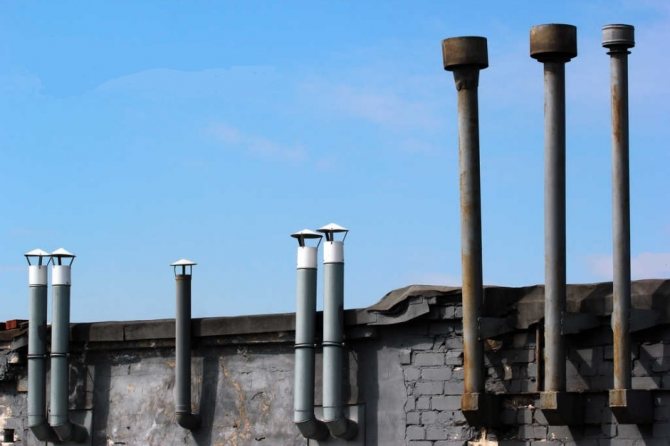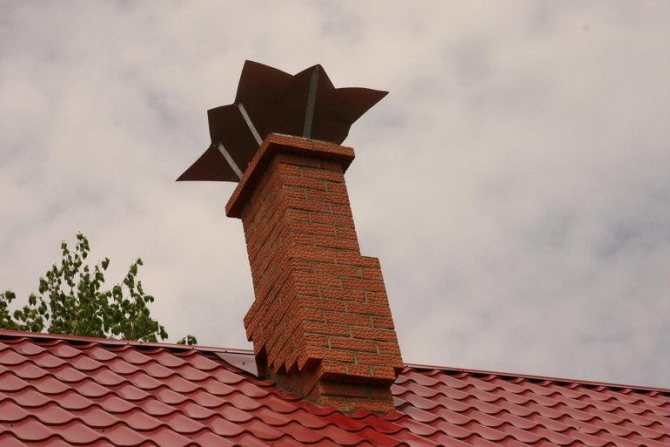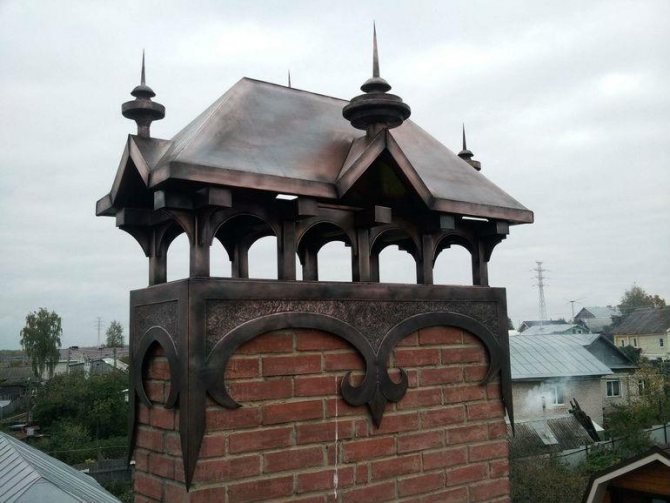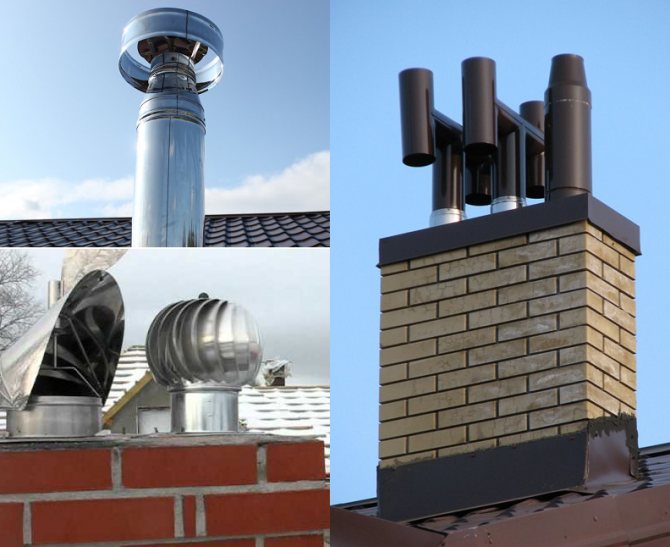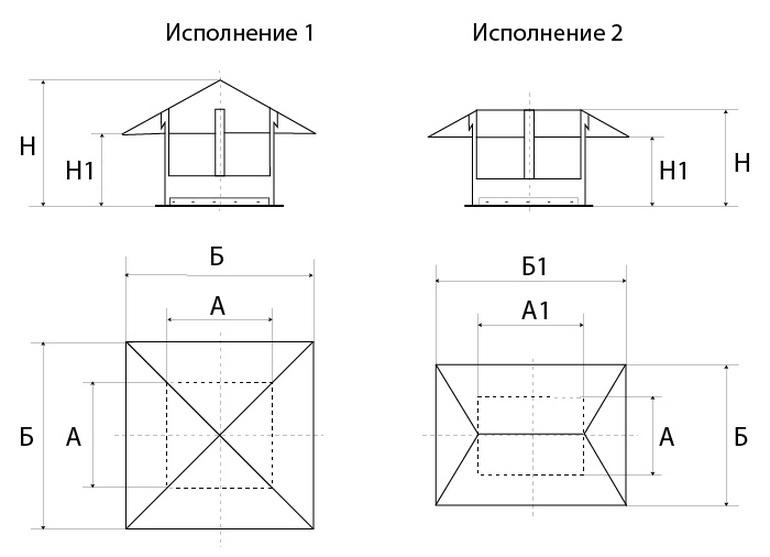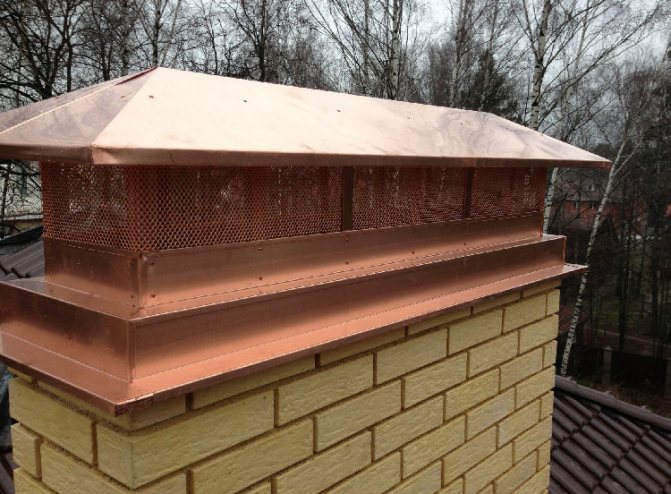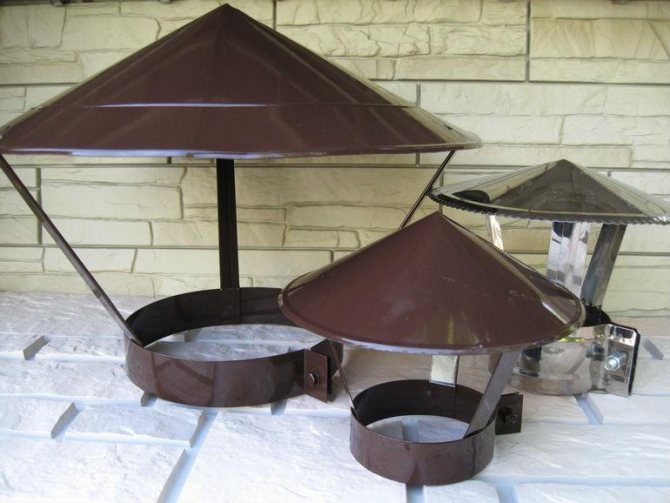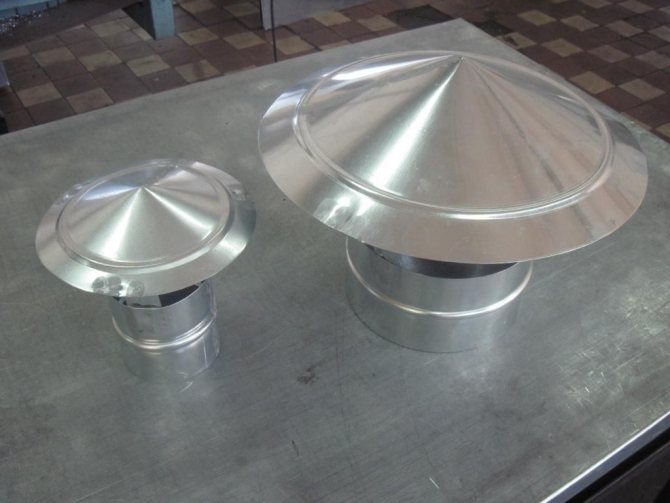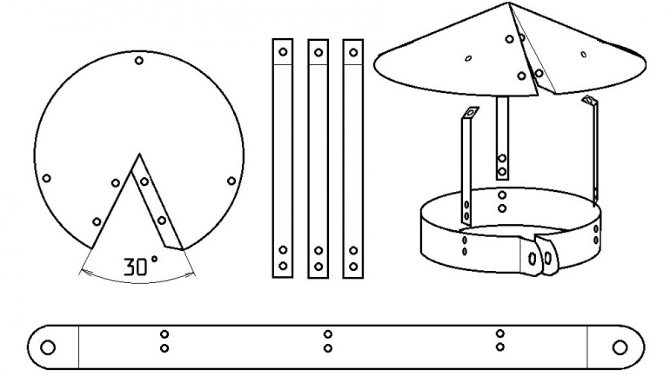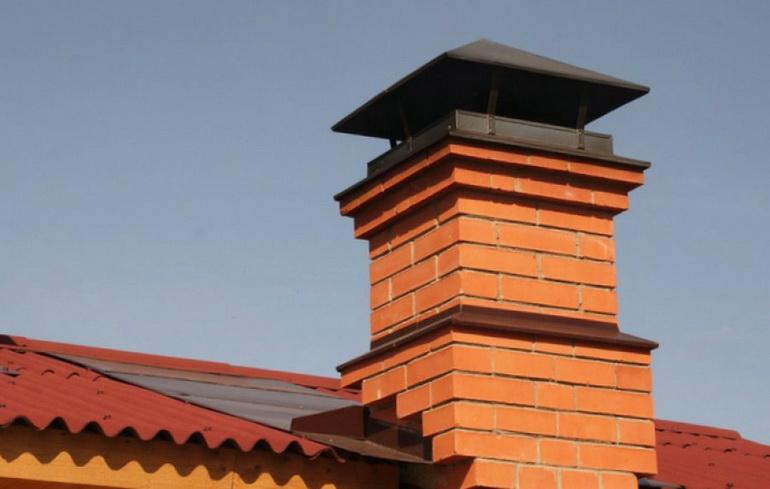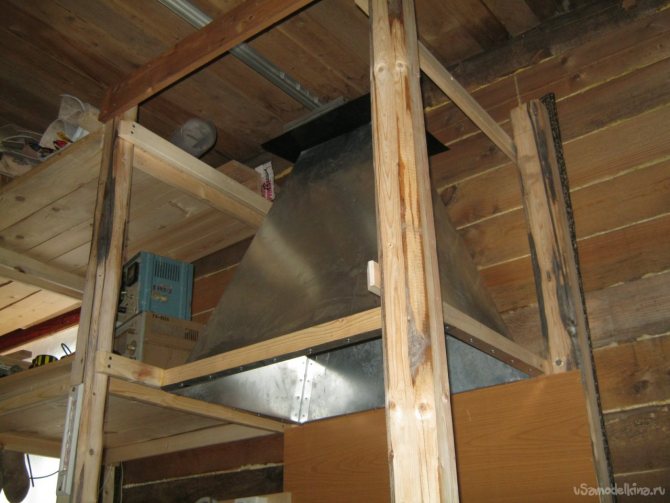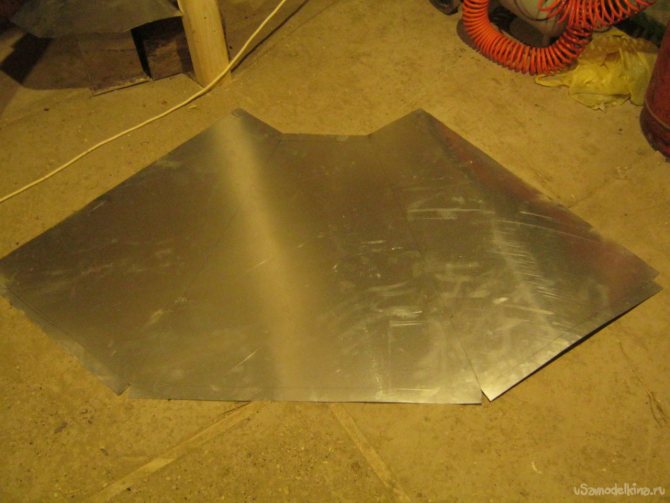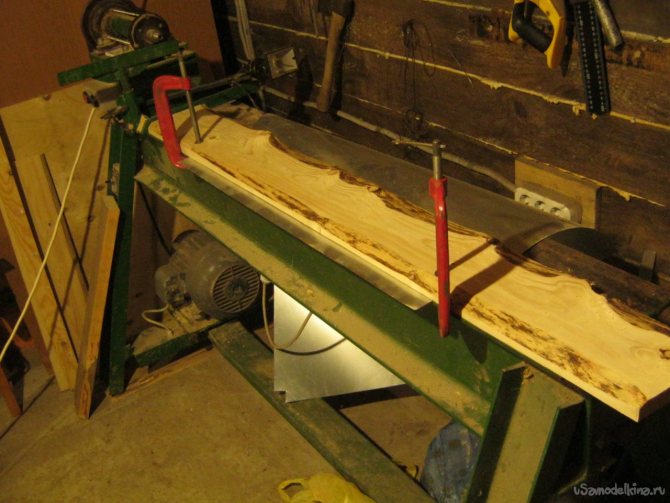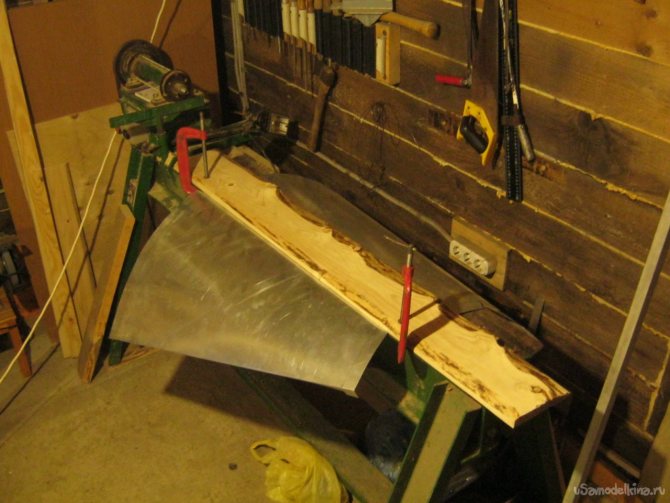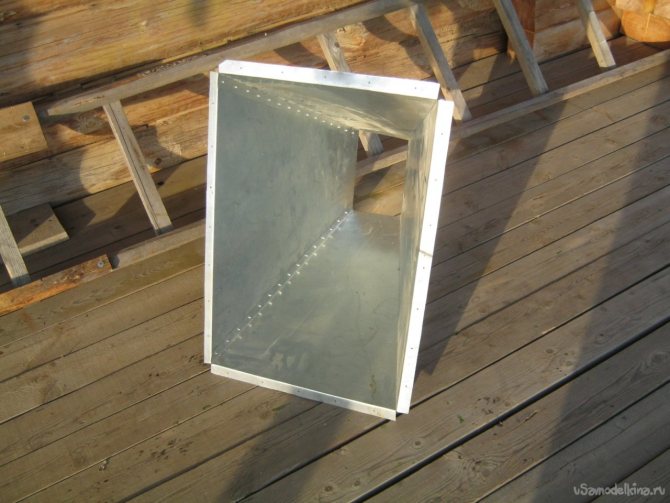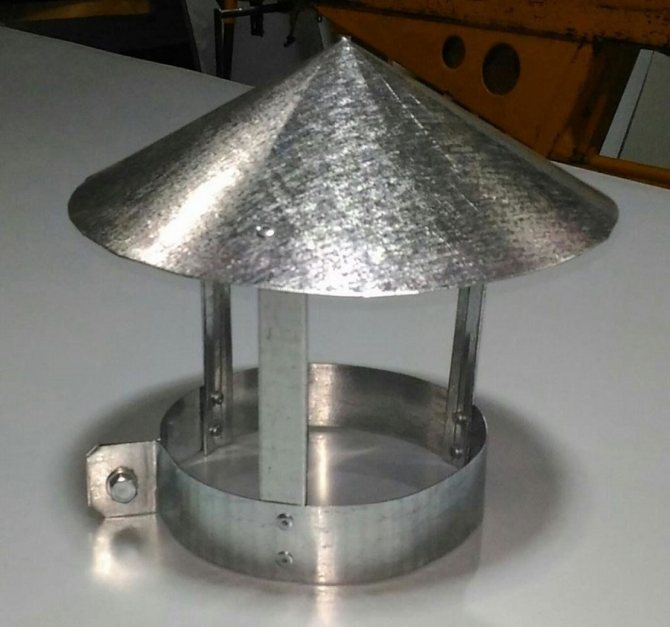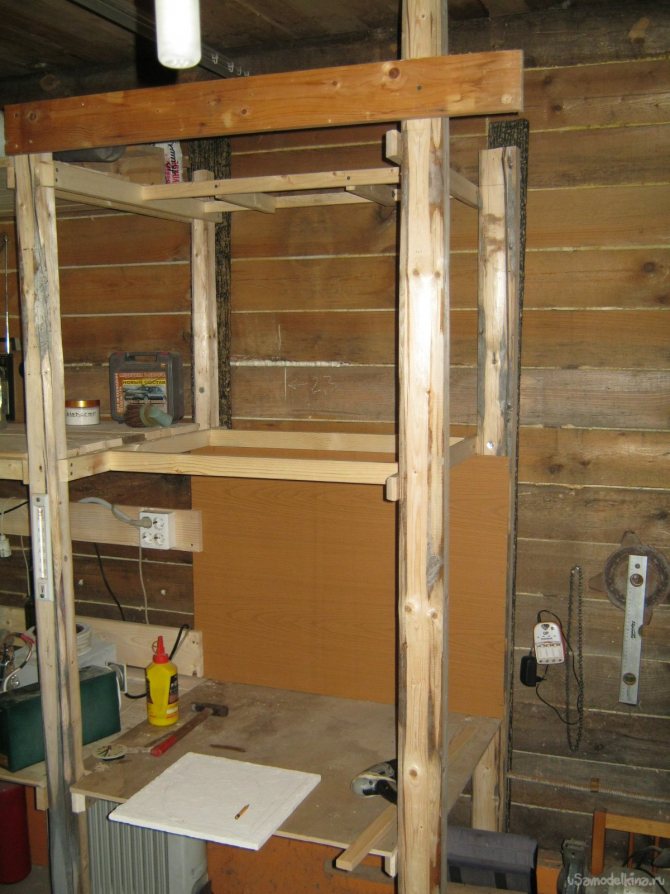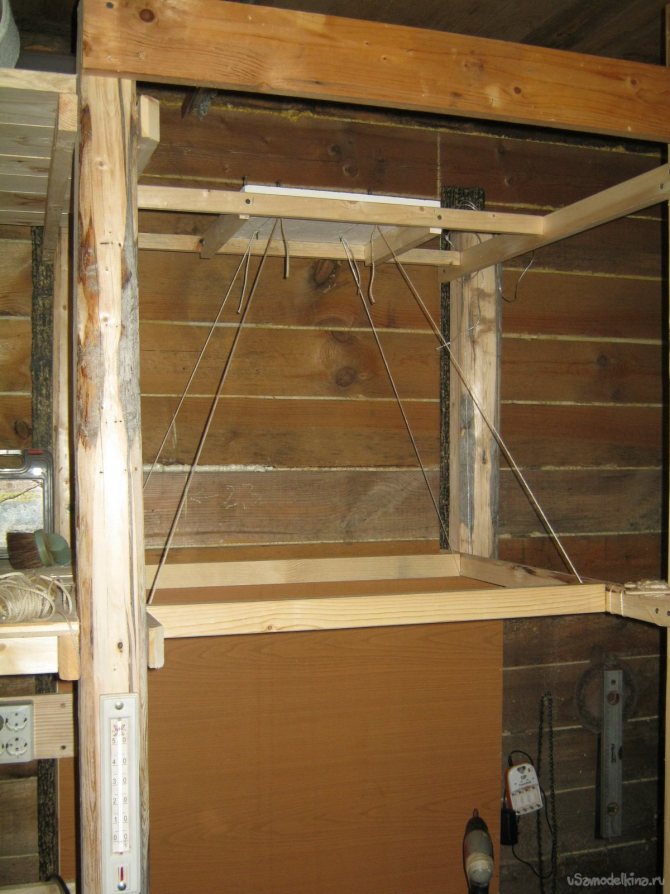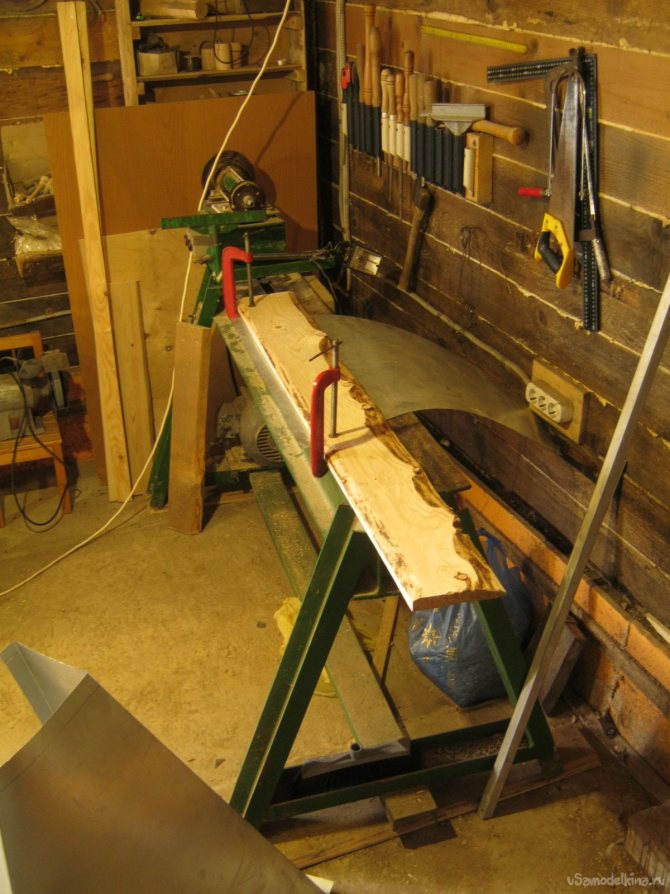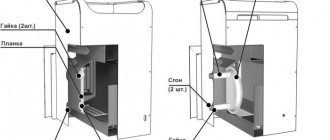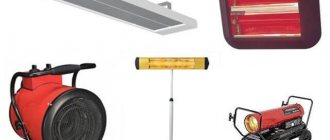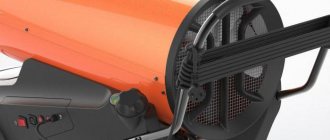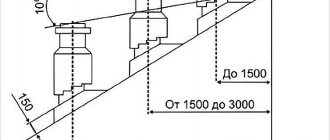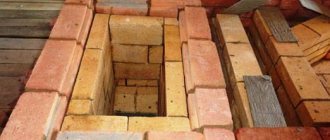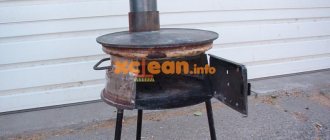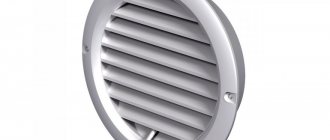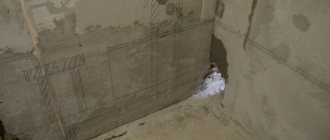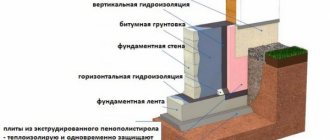Complementary elements for the roof are represented, in most cases, by metal or modern plastic products.
Such elements are used in the areas of roofing joints, and also close the joints and ends, which gives the structure additional strength and protects it from the effects of destructive moisture.
The category of additional elements also includes smoke umbrellas, which are an integral part of both steel chimneys and classic brick chimney systems.
Chimney umbrella - what is it and why is it needed
A protective umbrella is the top of a cap, which in appearance can be a cone, pyramid, semicircle, or other more complex designs and shapes.
The functions of the umbrella that is installed on the chimney are as follows:
- the ingress of atmospheric water or snow into the chimney is prevented... A side effect of heavy rainfall is the accumulation of a large amount of moisture in the chimney, causing a decrease in natural air draft;
- arrangement of a brick chimney with an umbrella prevents material destruction, and the presence of special grooves allows all accumulating condensate to be removed in a timely manner;
- the presence of a chimney umbrella does not allow insects to enter the chimney, animals and birds, leaves and other objects carried by gusts of wind.
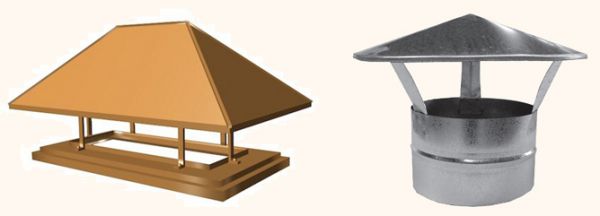
Chimney umbrellas
IMPORTANT!
You also need to remember that when using an umbrella, traction is noticeably improved, and the standard indicators for increasing this level of this parameter are about a third of the total volume.
The umbrella does not prevent the exhaust of smoke with combustion products only with the right choice of such a device... For example, in areas with heavy snowfall, it is advisable to use additional elements with a large angle of inclination for the unimpeded descent of the snow mass.
What tasks does a protective umbrella perform?
Installing an umbrella on the chimney helps to maintain the heating system in optimal mode, prevent premature aging of the chimney, and improve air circulation in the house.
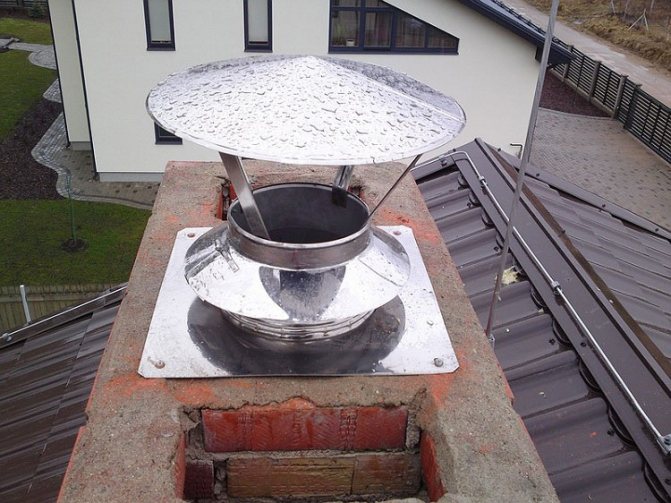

Pipe caps and caps are designed for the following purposes:
- close the ventilation duct, protecting it from rain, snow and dirt. Lack of protection can lead to the accumulation of a large amount of water in the chimney, which contributes to a decrease in draft and, accordingly, a drop in the efficiency of the heating system;
- protect the pipe material from damage by draining the accumulated condensate due to the presence of special grooves;
- do not allow insects and birds to fall into the pipe, serve as an obstacle to leaves and branches from trees;
- perform a decorative function. They give the roof a complete look, especially if there are elements of artistic forging in the structure.
Note! With the help of an umbrella, you can solve one of the problems of dampness in the house or bath. If the chimney is exposed to all winds and rains, moisture that has got into it penetrates into the premises. As a result, the walls and floors are affected by fungus, and an unpleasant odor appears in the air.
Some types of hoods are designed to create a rarefied environment in the upper part of the pipe. Due to this, an improvement in the draft in the chimney is achieved, excess moisture, exhaust air and combustion products are removed faster.
What is the difference between an umbrella and a weather vane, a cap, a head and a chimney
A chimney, a weather vane, a cap, an umbrella and a head - rather simple and time-tested protective structures for air outlets on the roof... Steel, copper, aluminum, plastic and titanium-zinc additional elements, if properly arranged, have been in operation for ten, and sometimes more, years, providing comfortable and safe living:
- caps - the general name for elements that prevent atmospheric precipitation and foreign objects from entering the chimney, as well as carrying a decorative load;
- chimneys - rectangular or square decorative caps designed for arranging chimney and ventilation pipes;
- umbrellas - presented by caps, characterized by a simple design and intended for round or square pipes;
- deflectors - caps for round pipes, characterized by a rather complex internal structure to increase traction.
Wind vane also belongs to the category of complex structures. - rotating hoods directing the outgoing smoke exclusively in one direction, depending on the direction of the wind.
NOTE!
Umbrellas are used to equip a round or square head, but modern manufacturers, in addition to functionality, take into account ease of use, including the addition of a cover with a smoke divider.
Types of protection for the chimney and ventilation pipe
The classification of types of umbrellas is due to the shape, purpose, as well as the materials used in the manufacture.
Depending on the shape, the most common are standard designs that repeat the appearance of a hipped roof, as well as varieties in the form of a mushroom head.
Varieties can be represented by droppers and drainage systems, designed to collect and further drain all flowing moisture, as well as prevent it from getting inside.
Various non-ferrous or ferrous metals can be used to make a fungus or an umbrella, but galvanized durable steel is most often used.
Deflectors also belong to the varieties of the smoke umbrella, which serve as a very effective spark extinguisher.
The appearance of the structure and materials for the manufacture of the chimney "fungus" do not have a significant effect on the performance indicators, therefore, when choosing, consumers should focus on finances and personal preferences in decor.
Selection and installation of an exhaust deflector
Unlike an umbrella, it is quite difficult to make a beautiful and flawlessly working turbine deflector by yourself. Although, if you have the patience, enough for cutting and riveting metal with a set of tools and a proven blade pattern, this is quite possible.
If there is no desire to get involved with precision cutting, then the kits for assembling the turbine deflector are actively offered by Chinese trading sites. The customer of such a set will simply need to assemble everything according to the instructions and put rivets on each blade.
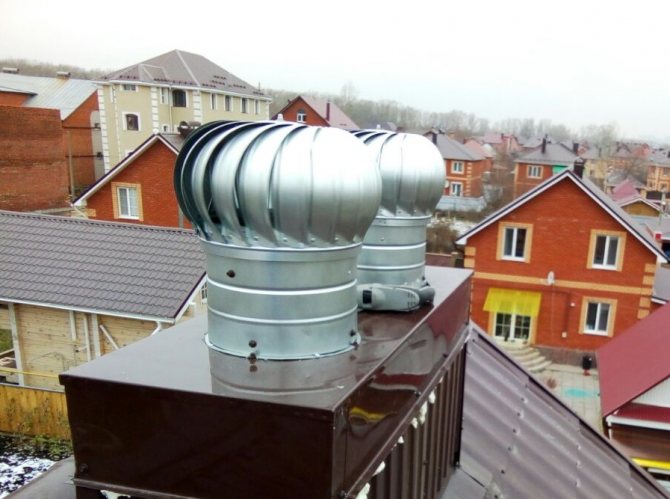

Manufactured turbine deflectors are equipped with bearings for easy rotation. Such umbrellas are well balanced, which eliminates friction of parts during operation and ensures a confident start even in the smallest wind.
To select the correct deflector, two main factors must be taken into account:
- Diameter and design compatibility with your ventilation pipe;
- Compliance of the deflector with the climatic conditions of the area in which it will work.
The first indicator guarantees you a tight and secure attachment of the ventilation hood to the exhaust outlet.
Due to the large blowing area, the deflector experiences strong wind loads, so it must be securely fastened during installation. Also, the connection between the ventilation pipe and the deflector must not have leaks, due to which the ventilation hood may move.
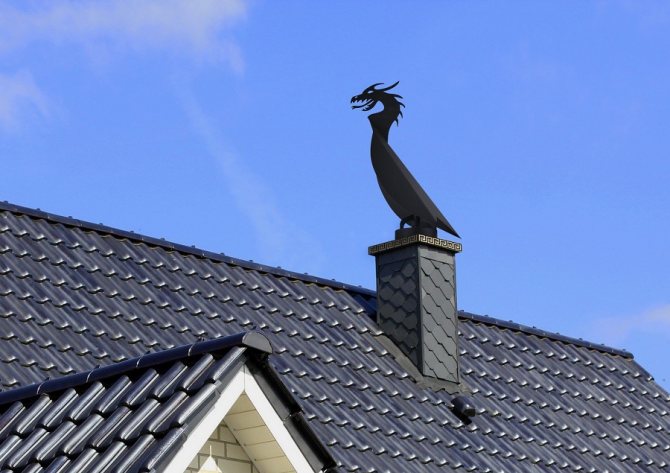

The original deflector weather vane, in addition to improving traction and protection from precipitation, is able to emphasize the uniqueness of your roof design
Climatic conditions are also very important. If there is a lot of wind in your area, then there is no need to install turbine deflectors and hoods in the form of weather vane on the hood, they are needed where traction is required in all possible ways.
However, they will not be able to work effectively in areas with frequent snowfalls and temperature fluctuations near zero degrees, as they will be covered with an ice crust, lose mobility and will not be able to adapt to the direction of the wind flow.
The TsAGI and Volpert deflectors, although less effective in creating thrust in the wind, do not include rotating parts that are afraid of icing. These deflectors are maintenance-free and less expensive.
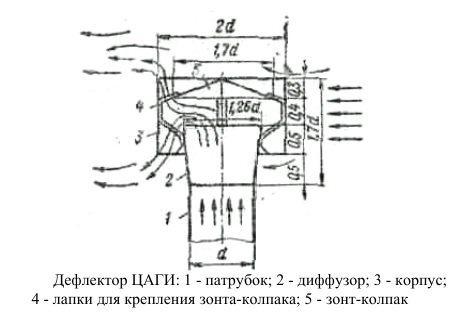

To ensure the correct movement of ventilation and wind air flows and to increase traction in the manufacture of the TsAGI deflector, it is necessary to observe the correct dimensions of its elements. These dimensions primarily depend on the diameter of the ventilation pipe, so they can be calculated independently
If you have chosen the right deflector for your ventilation pipe, then its installation will not cause difficulties. Deflectors are mounted on the ventilation pipe, as a rule, on clamps or self-tapping screws.
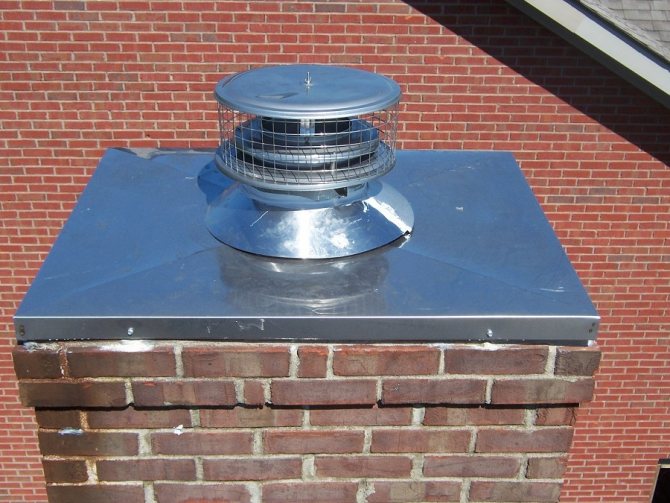

To install the deflector on a square or rectangular ventilation pipe, use an adapter plate, which you can purchase with a deflector or make yourself
When choosing a deflector with a complex design for the manufacture of a ventilation fungus, make sure that you have the opportunity to conveniently maintain it on the roof. Indeed, even the simplest fungus may require periodic cleaning of frost or lubrication of rotating parts.
How to choose a chimney umbrella
When choosing an umbrella designed for chimneys, as well as ventilation outlets, you need to pay attention to the quality of the material, and also take into account the diameter of the outlet and the item being purchased.
The system of protection from external unfavorable factors should be thought out even at the design stage of the flue gas outlet, with the obligatory consideration of all design features.
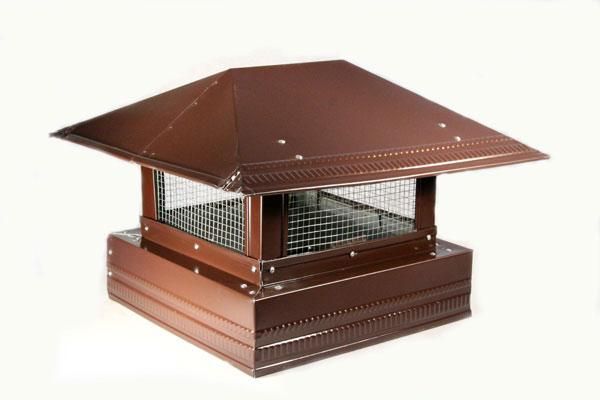

Umbrella with safety net
Basic installation rules
The installation of a smoke umbrella directly depends on the design features of the additional element and the chimney, as well as the material used in the manufacture. Based on standard rectangular sheet steel, the easiest way to create a tetrahedral pyramidal umbrella is by bending the sheet of material a couple of times in the diagonal direction.
This option is traditional for arranging chimneys on hipped roofs, but for attaching racks and further installation, it is necessary to use additional elements in the form of corners, as well as drill holes.
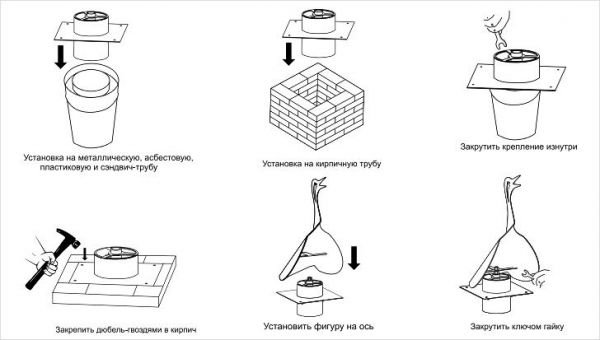

Installation of a weather vane
Simple vaulted umbrellas with a minimum number of folds and cuts have a less complex design. The fixing of such a smoke umbrella on an oval chimney pipe is carried out due to the presence of racks bent from sheet steel of sufficient thickness or made using standard metal corners.
Regardless of the manufacturing method, the racks can be fixed in several ways:
- on metal and asbestos chimneys, you can use a metal clamp or make a regular wire frame yourself;
- the wire for the frame base should be as strong and reliable as possible;
- mounting holes are drilled in the racks;
- The lead-out parts of the twisted wire frame are passed through the fastening holes on the posts and screwed until the smoke umbrella is fully fixed.
On brick chimneys, even standard galvanized nails of sufficient length, implanted directly into the masonry, can be used to fix the "umbrella". However, as practice shows, it is best to drill holes in the brickwork through the pre-drilled holes in the umbrella posts, then fix the hood on the chimney with steel pins or galvanized screws.
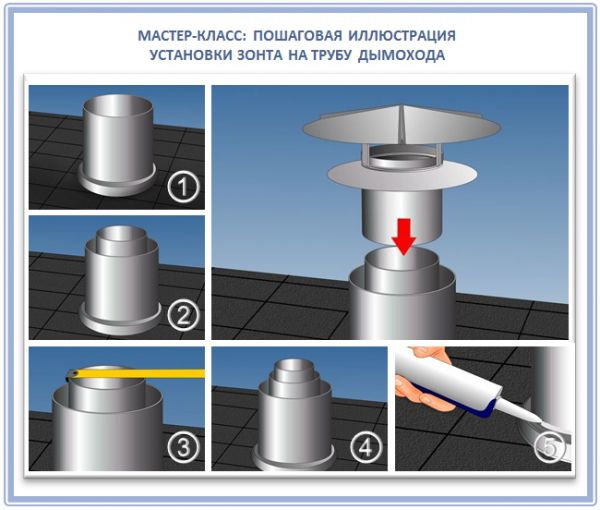

Mounting the umbrella
In this case, if necessary, it will be possible to quickly and with minimal effort to independently dismantle the umbrella for cleaning or replacement.
CAUTION!
It should be remembered that when using a gas system as an autonomous heating, it is strongly not recommended to install an umbrella on a chimney.
Types of industrial exhaust hoods for ventilation
According to their design features and purpose, ventilation elements are divided into two large categories:
- supply and exhaust, which not only remove polluted air from the room, but also provide an inflow of fresh air. Their installation is advisable at those facilities where the access of fresh air is significantly difficult or it is required to supply it directly to the workplace;
- exhaust, carrying out preliminary cleaning and air removal. Similar structures are installed in rooms where supply ventilation is implemented by a separate system.
Several types of products are also produced, which differ in the way of installation:
- so-called crossings or "barbecue" ventilation hoods. They are mounted directly over an open fire, in the form of a pyramid or truncated cone. They are widely used in catering establishments;
- wall-mounted, which are securely attached to the wall and do not create problems with installation;
- island. They are fixed on the ceiling above the equipment located at a considerable distance from the walls.
All structures can be domed, triangular or trapezoidal. The choice of the appropriate option depends on the specific features of the activity of a particular company.
How to make an umbrella on a chimney with your own hands
Before manufacturing, the diameter of the chimney is necessarily measured, and the step-by-step manufacturing technology for such a structure is as follows:
- cut a tin strip 70-80mm wide and length depending on the diameter of the chimney with the addition of a small margin for fastening;
- on a caliper, draw the strips with an indentation of 10 mm from the edge of the tin strip;
- hammer through the rails in accordance with the marked stripes, which will allow you to easily and evenly fold the workpiece;
- make four parts according to the strip marks, tap, make a right angle, wrap and finally punch with a hammer;
- prepare a cardboard round patternthe diameter of which exceeds the size of the chimney by 150 mm;
- cut out a tin circle for the umbrella in accordance with the prepared template and cut out an angle that allows assembly in the form of a cone.
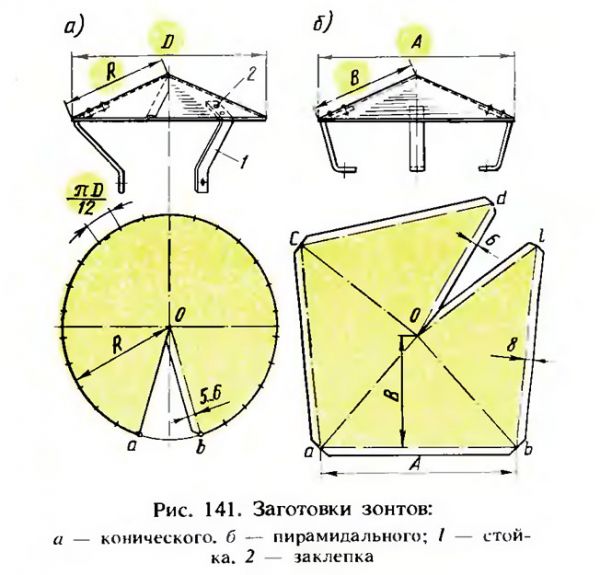

DIY umbrellas
The finished umbrella must be riveted in a couple of places, after which it is required to attach three reinforcement strips or so-called racks to the structure.
IMPORTANT!
The easiest way to improve the appearance of the finished structure is to beautifully design the edges.... For this purpose, you can make metal cuts along the edges and slightly bend the resulting "petals" or bend the wave-like cut edges.

